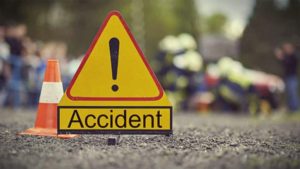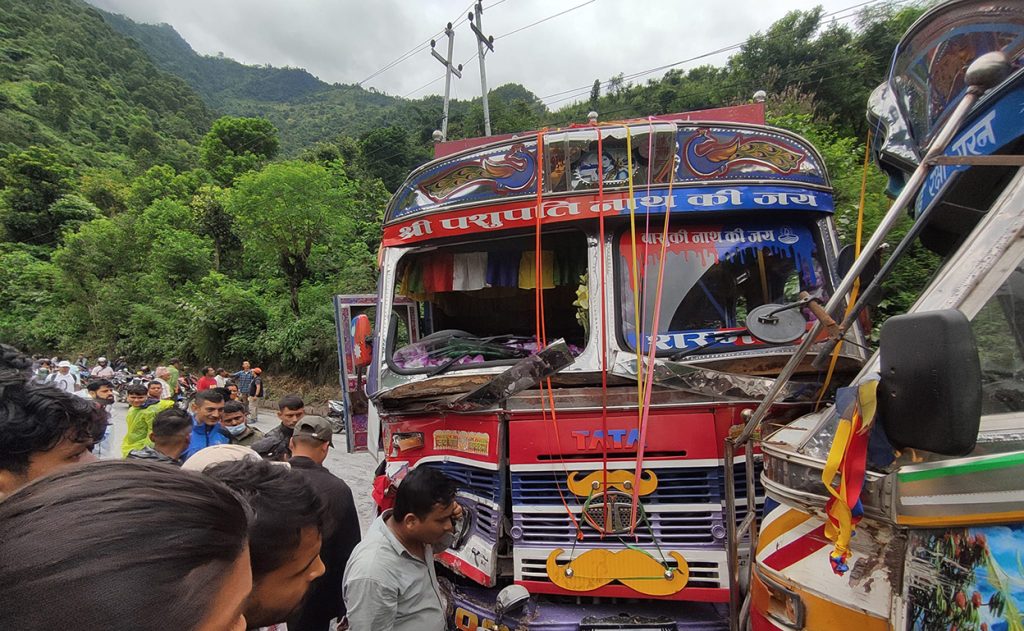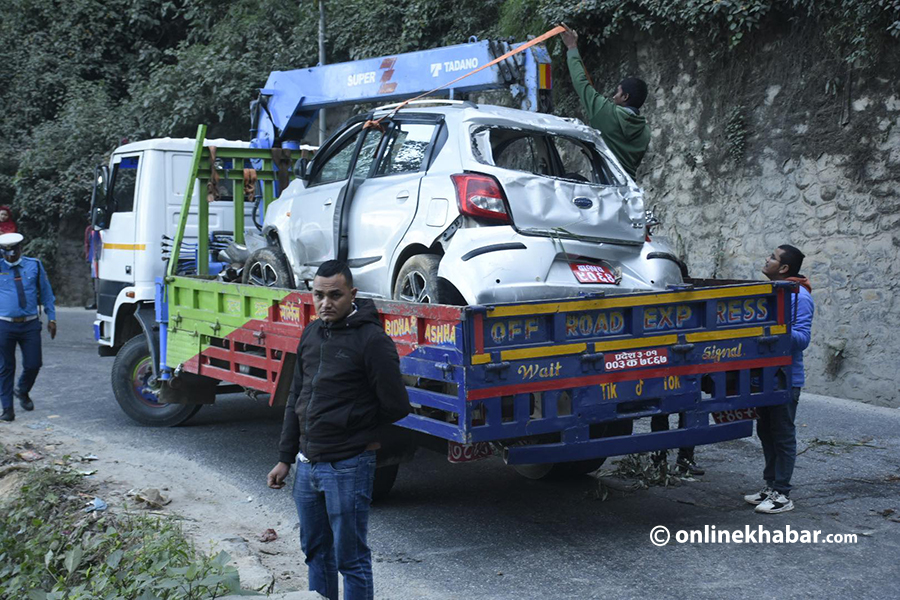
On January 28, singer Pramod Kharel was performing at the Dhankuta Festival at Dhankuta Stadium. As he was about to get on stage, things went ugly. A stampede at the entrance of the stadium injured around 30 people including a few critically. Fortunately, no one died.
A team of officials from the district administration office in Dhankuta investigated the incident and concluded the concert was attended by more people than expected and the capacity of the public infrastructure, resulting in the stampede.
“The incident happened due to a lack of other entry points. This could have been avoided if the organisers had set up the gates in an open place,” says Dhankuta Chief District Officer Lila Kumari KC Pandey.
—
On February 4, a few people fainted at the entry point of the National Industrial Trade Fair held in Hetauda. As the place got more than the anticipated crowd, a stall had to be removed to create an exit to make things easier for those who attended the fair.
To stop people without tickets from entering these fairs and concerts, organisers put up temporary fences. These organisers do not know how many people will attend any fair or concert organised in any public infrastructure. They do not prepare contingency plans leaving the crowd vulnerable to unexpected incidents like stampedes.
Football and cricket tournaments organised outside the Kathmandu valley are prone to accidents as the stadiums do not have the proper infrastructure to manage the number of spectators.
Throwing stones and bottles onto the field by the excited crowd when their teams win or lose has become a common phenomenon at football tournaments outside the valley. As this cannot be predicted, it has become a major challenge for the police to provide security in these competitions as sports infrastructure like any other public infrastructure is poor in Nepal.
On top of that, organisers have a bad habit of issuing tickets without considering the capacity of the venue. This leads to overcrowding on a massive scale as they do not think about the issues that might come due to poor public infrastructure as most venues do not have emergency exits.
Failure to learn a lesson

Chairman of Nepal Structural Engineers Association Rajan Suwal says the security aspect of sports and other public events at open public infrastructure is weak. He says event organisers should always have a contingency plan at hand keeping in mind anything bad can happen at any time.
“They think building gates and high walls will solve issues. It will not. Open spaces inside and outside these gates are just as important,” he says. “In Nepal, we close the gates after sending people in, it can cause major accidents.”
The same problem exists in public parks, amusement parks and water parks built near cities. These places are full of children during holidays. But, poor management of these parks is posing risk to people who go there to have fun.
An example of how poorly built public infrastructure can cause major issues is what happened at Dasharath Stadium on March 12, 1988.
Thousands had gathered to watch the final of the Tribhuvan Challenge Shield, between Janakpur Cigarette Factory and Mukti Joddha from Bangladesh. As the game was going on, a storm was brewing in the sky. Before anyone could react, the thunderstorm hit the stadium and people ran to get out of the stadium. The doors of the stadium were locked and the panic led to a stampede killing 93 people.
The then education minister Keshar Bahadur Bista resigned on the grounds of morality after such a tragic accident occurred. Incidents like these have shown that if adequate attention is not paid to security while building and operating public infrastructure, fatal accidents are unavoidable in such public spaces.
Looking back at the incident, Bista says there has been improvement in some aspects, but he still sees the need to do more to make the places like Dasharath Stadium safe for fans.
“The incident taught us we need a proper plan to evacuate the place easily within 10 seconds. But, sadly, we still lock doors during events in Nepal. It’s like we haven’t learnt from our mistakes,” says Bista.
Former Secretary Kishor Thapa, who witnessed that terrible incident at the Dasharath Stadium, feels such incidents can happen at any time. He feels people who organise large fairs, programmes and meetings at a public infrastructure do not give much thought to managing the crowd or making arrangements for evacuation.
“Having witnessed the Dasharath Stadium disaster, I can say that our public infrastructure is still not built safely,” he says. “We have policy and rules but these aren’t implemented.”
Irresponsible event organisers

The safety of common people who gather in public places is a matter that cannot be compromised. Although this is basically the responsibility of the state, the relevant organisers should also be held accountable. The people who attend these programmes should also be careful and alert.
The poor management of crowds at religious fairs, festivals and cultural processions across the country, including Kathmandu, shows that a serious accident is in the waiting at any public infrastructure. Stones are pelted in Bhaktapur’s Biska Jatra every year. During these times, the police cannot control the crowd.
On April 9, 2016, 45-year-old Laxmi Prasad Tyat died after getting caught up in a riot. Last year, Durga Man Kasapal, 71, died after getting crushed by the chariot during the procession.
These are common incidents that happen regularly during festivals across the country, which, time and again, have put the lives of people at risk.
The temples across the country are also the major hotspot for accidents as they have poor and inadequate infrastructure. On top of that, due to the lack of planning to deal with problems that may occur suddenly and the lack of maintenance of religious places and heritage sites, the risk of accidents has to be borne by the people themselves.
An example is how 75 people died in two churches during the 2015 earthquake in Sitapaula and Kapan of Kathmandu. Some died when the building collapsed while some died due to a stampede following the earthquake, police investigation revealed.
Even now, attention has not been paid to building and managing public infrastructures keeping in mind the accidents that may occur when pilgrims gather in areas like Ason and Indra Chok of Kathmandu.
Perpetual threat

Nepal’s public infrastructure including roads and bridges is not safe either. Take what happened at the Subaghat Fair in Surkhet on December 25, 2017, when 25 people died after a suspension bridge collapsed due to overcrowding. Many visitors who came to fill the fair fell into the Bheri river along with the bridge.
The government did not learn a lesson from that as something similar happened when a bridge in Pashupati temple collapsed on Mahashivaratri in 2022. A few people fell into the Bagmati river but there was no loss of life.
The suspension bridge at Sanga in Bhaktapur is overcrowded with locals every Saturday. But no one has done anything to change this as locals fear the bridge will collapse one day.
Even some concrete bridges are facing such safety challenges. The Road Department has not used the bridge built over the river Bishnumati in Teku of Kathmandu after it was found to be substandard.
However, the other old bridge next to the same bridge is full of vehicles during rush hour. Experts argue a large number of vehicles on a bridge is dangerous. Suwal believes that if the public infrastructure is built with a load-carrying capacity of one level, it may cause an accident during a disaster like an earthquake.
Bridges built around religious places all over the country have a high traffic of people and vehicles during special events and festivals. However, no interest has been given to checking the load-carrying capacity of those bridges and managing them accordingly.
During the 10th general convention of UML in November 2021, public concern was expressed after a sea of people walked over the Narayani bridge in Narayangadh.
Unsafe skyscrapers

The private sector also is at fault as far as the safety of public infrastructure is concerned.
When the Soaltee City Apartments caught on fire on January 18, 2021, it showed poor emergency arrangements at skyscrapers in the country. The situation was so dire that people could not escape the apartment during the fire. The rescuers entered the apartments and rescued 23 people who were trapped.
The apartment had only one fire exit that was on the inside. On top of that, the police came to the conclusion that there were problems in getting out because there were goods in some places inside the stairs.
According to the rules, every floor of a large building must be equipped with fire fighting equipment such as fire hoses (pipes that are prepared for water to extinguish fires) and fire extinguishers. There should be a fire exit from inside and another emergency ladder from outside.
For such emergencies, even if the fire brigade does not come on time, these buildings should have enough water in their tanks to deal with the fire too.
Even in the shopping malls from Bhatbhateni to Salesberry, which are always crowded with people, crowd management has not been given enough attention. These shopping malls also do not have enough elevators to carry shoppers.
On top of that, most apartment buildings in the country have narrow staircases, which is another issue when a large number of people are trying to escape a building.
Min Man Shrestha, a former president of the Nepal Land and Housing Developers’ Association, says that non-compliance with safety standards is against professional ethics and is risking major incidents from happening in the country.
“In case of any disaster including earthquake and fire, public infrastructure should be ready to ensure people can get out of the buildings easily and safely,” says Shrestha. “If buildings are constructed without regard to security, the government should pay attention to it.”
The technicians of the Department of Urban Development and Building Construction also say that most of the commercial buildings including apartments and malls in Kathmandu do not have emergency doors and ladders to escape in case of calamities.
“Many apartments in Kathmandu are vulnerable to disasters,” says an engineer from the department. “Buildings have been given green light to build in a haphazard manner.”
Night clubs in the cities also have the same problems. The entrance and exit of these clubs are narrow. Experts fear what can happen in case of fires or other disasters. Cinema halls and auditoriums are also built in a similar manner.
In recent days, cinema halls are built in the mall itself. Similarly, in government offices, auditoriums are built in a haphazard manner.
School buildings and infrastructure are also poor in Nepal. On October 17, 2019, 7-year-old Sansana Sada was crushed to death when the wall of the KSSB High School building at Janakandini-4 in Dhanusha collapsed. Mohammad Samir Safi, 6, was injured in the incident.
On July 1, 2016, Kripa Rai and Anjana Pun Magar of Godavari were killed when a wall collapsed at Pushpanjali Secondary School in Taukhel, Lalitpur. Twenty students were injured in the incident.
The 2015 earthquake also gave an example of how unsafe school infrastructures are. Coincidentally, as it was Saturday, the students were celebrating the holiday at home that day. It is also difficult to estimate how many students could have been injured when 21,169 classrooms of 9,072 government schools were completely destroyed in only about 29 districts.
Meanwhile, most of the private schools are run in rented houses built for residential purposes, where there is not enough open space.
Suwal says that the schools located in residential houses built to bear the burden of a family add a big challenge to public infrastructure safety.
Former education minister Bista recalls that after the Dasharath Stadium disaster, he issued a circular to consider the safety of school buildings.
“The earthquake also taught us a big lesson, but no one is interested in ensuring that students reach a safe place in an emergency,” says Bista.
This story was translated from the original Nepali version and edited for clarity and length.






















